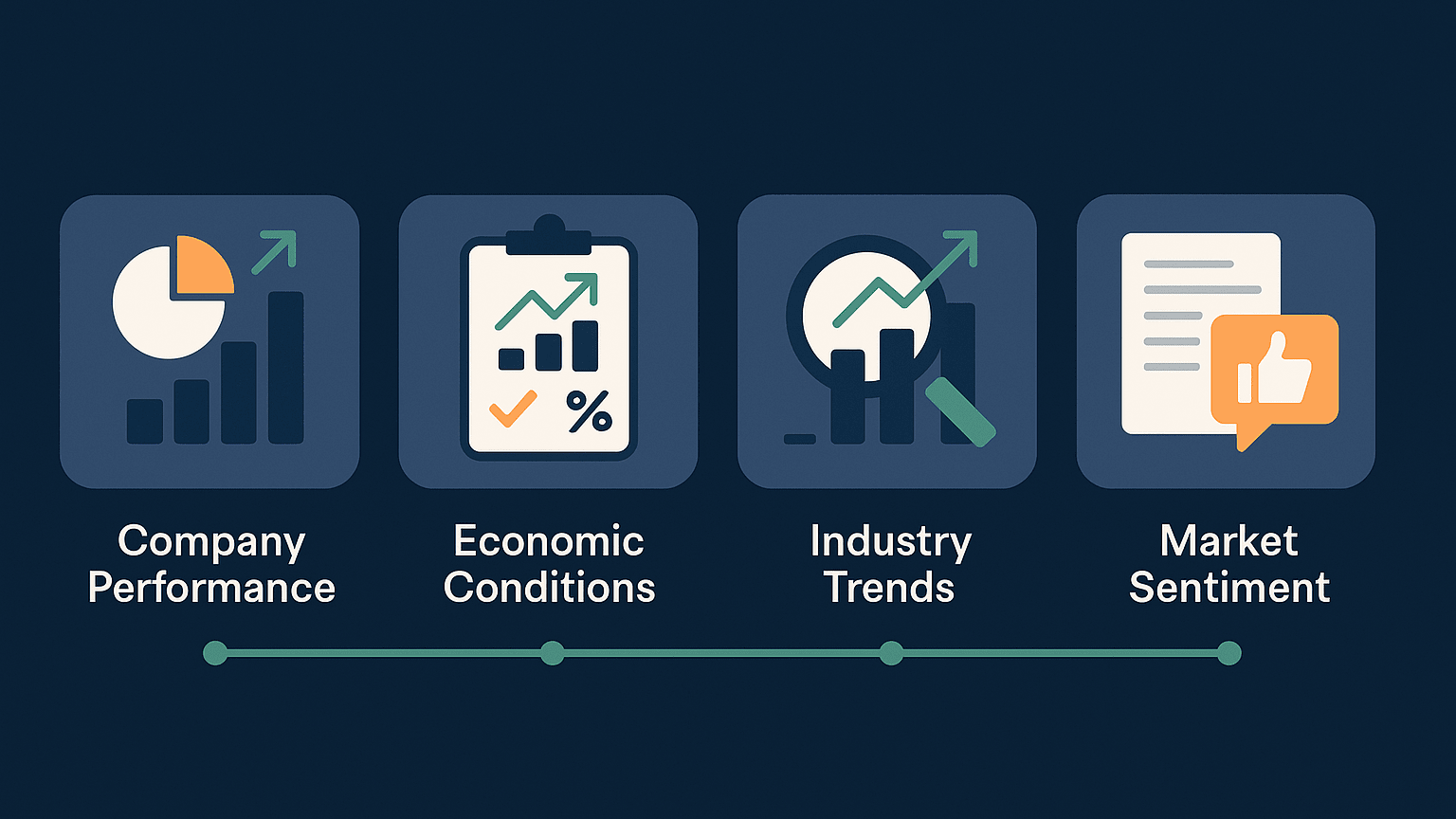Learn the fundamentals of stock investing, including types, market operations, and strategies for building a successful portfolio.
Stocks are a way to own part of a company and grow your wealth. This guide covers the basics of stocks, how markets work, and tips for investing. Here's what you'll learn:
- What are Stocks?: Ownership in a company, offering voting rights (common stocks) or fixed income (preferred stocks).
- Stock Market Overview: How exchanges like NYSE and NASDAQ operate, trading hours, and market trends.
- Price Drivers: Factors like company performance, economic conditions, and industry trends affect stock prices.
- Types of Stocks: Growth vs. value stocks, large-cap vs. small-cap, and U.S. vs. global stocks.
- Investing Steps: Setting goals, choosing brokers, balancing portfolios, and using research tools.
Quick Tip: Start with small investments, diversify across industries, and focus on long-term growth. Stocks can average a 10% annual return, but understanding market dynamics is key to success.
How does the stock market work?
Stock Market Basics
Stock exchanges are structured platforms where buyers and sellers trade shares of companies. Grasping how these markets operate is crucial for new investors and lays the groundwork for making smart trading decisions.
Stock Exchange Functions
In the U.S., the two leading stock exchanges are the New York Stock Exchange (NYSE) and NASDAQ. While they share the goal of facilitating trades, they operate differently. The NYSE, established in 1792, uses a physical trading floor where designated market makers (DMMs) maintain liquidity and orderly trading. NASDAQ, launched in 1971, is entirely digital and operates exclusively online.
Trading hours for both exchanges are Monday through Friday, 9:30 a.m. to 4 p.m. Eastern Time, excluding holidays. Each exchange also enforces its own listing requirements.
| Exchange Feature | NYSE | NASDAQ |
|---|---|---|
| Trading Style | Auction market with DMMs | Electronic dealer market |
| Company Focus | Established corporations | Tech and innovative firms |
| Market Structure | Physical trading floor | Fully electronic |
| Global Ranking | Largest by market cap ($28.32T) | Second largest ($26.62T) |
Price Movement Factors

Stock prices fluctuate based on supply and demand. As Benjamin Graham, mentor to Warren Buffett, once said:
"In the short run the market is a voting machine, and in the long run it is a weighing machine".
Several factors influence price changes:
- Company Performance: Earnings reports, product launches, and leadership shifts.
- Economic Conditions: Interest rates, inflation, and overall economic trends.
- Industry Trends: Changes or advancements within specific sectors.
- Market Sentiment: How investors react to news and events.
Interestingly, research from some investment firms suggests that overall market and sector trends account for about 90% of a stock's price movement. For instance, S&P 500 companies are projected to see earnings grow by 11% in 2024, with even higher growth of 14% expected in 2025.
Major Market Indexes
Market indexes track the performance of stock groups, offering benchmarks to assess market trends. The S&P 500, which includes around 500 of the largest U.S. companies, has historically delivered an average annual return of 10.5% since its inception in the 1920s.
Here’s a look at some key global indexes:
| Region | Major Index | Notable Feature |
|---|---|---|
| United States | S&P 500 | 500 largest U.S. companies |
| United States | Dow Jones | 30 major American corporations |
| Japan | Nikkei 225 | Leading Japanese companies |
| United Kingdom | FTSE | London Stock Exchange benchmark |
| Germany | DAX | Top German corporations |
| China | CSI 300 | Major mainland China stocks |
Stock Categories
Different stock categories cater to various investment goals like growth, stability, and income. Understanding these categories can help refine your investment strategy.
Growth and Value Stocks
Growth and value stocks represent two distinct investment styles. Growth stocks focus on reinvesting profits to expand and innovate, often excelling during strong economic periods but with higher volatility. Value stocks, on the other hand, are priced lower relative to their earnings and often provide steady dividends, making them more stable.
| Characteristic | Growth Stocks | Value Stocks |
|---|---|---|
| Price Relative to Market | Generally higher | Generally lower |
| P/E Ratio | Above-average | Below-average |
| Dividend Policy | Low or none | Usually higher yields |
| Risk Level | Higher volatility | Lower volatility |
| Growth Rate | Above-market average | Steady, moderate |
Value stocks are known for their consistent performance, even in uncertain markets, while growth stocks aim for rapid expansion.
"It's far better to buy a wonderful company at a fair price than a fair company at a wonderful price."
Company Size Categories

A company's market capitalization determines its size category and investment characteristics. Here’s a breakdown:
-
Large-cap Companies
These are well-established firms, often called "blue-chip stocks", with market caps exceeding $2.4 billion. They provide stability and reliable returns, with large-cap funds averaging 7% returns over the past five years. -
Mid-cap Companies
Companies with market caps between $600 million and $2.4 billion fall into this category. They offer a mix of growth and stability, with mid-cap funds averaging 10.28% returns over the past five years. -
Small-cap Companies
These smaller businesses, with market caps below $600 million, come with higher growth potential but also greater risk. Small-cap funds have averaged 14.74% returns over the past five years.
Understanding these categories helps diversify investments across different market caps and geographic regions.
US and Global Stocks
Balancing domestic and international stocks can help manage risk while tapping into global growth. When venturing into international markets, consider:
- Currency exchange rate shifts
- Regulatory differences
- Economic cycle variations
- Market accessibility and trading hours
- Political and economic stability
Investors often begin with large-cap domestic stocks for reliability. For those seeking higher returns, small-cap or international stocks can offer greater potential but come with added risks like currency fluctuations and regulatory challenges. Diversifying across markets ensures exposure to varied opportunities and mitigates risk.
First Steps in Stock Investing
Ready to dive into stock investing? Here's a practical guide to help you get started.
Setting Investment Goals
Start by defining your goals. What are you aiming for – retirement savings, a down payment, or something else? Your goals will shape your investment strategy. For example, Morgan Stanley's 2024 research suggests that a 35-year-old saving for retirement might allocate around 80% of their portfolio to stocks, taking advantage of a longer time horizon. On the other hand, someone in retirement may opt for about 30% in stocks to prioritize income and stability.
"Investing isn't about choosing the stock that will get you rich quickly. It's about putting money to productive use in the hopes of earning a healthy return."
– Dan Hunt, Morgan Stanley
Picking a Broker
Choosing the right broker is crucial. Look for one that aligns with your needs in terms of tools, fees, and usability. Here's a quick comparison:
| Broker | Best For | Key Features |
|---|---|---|
| Fidelity | Beginners | Easy-to-use platform with plenty of educational tools |
| Charles Schwab | Paper Trading | Four free trading platforms and $0 commissions |
| Vanguard | Long-term Investing | Expertise in low-cost and index funds |
| Robinhood | Simple Platform | User-friendly mobile app with a streamlined experience |
Most brokers now offer commission-free trading for stocks and ETFs, and many have no minimum deposit requirements. Take time to explore their educational resources, research tools, and customer service to find the best fit.
Portfolio Balance
A well-balanced portfolio helps you manage risk and aim for consistent returns. A common starting point is a 60/40 split between stocks and bonds, but your ideal mix depends on your goals. Here's a breakdown:
| Investment Style | Stocks | Bonds | Best For |
|---|---|---|---|
| Aggressive | 90% | 10% | Long-term growth |
| Moderate | 70% | 30% | Balanced approach |
| Conservative | 50% | 50% | Income focus |
Diversify further by investing in 15–20 stocks across different industries.
Regular Investment Plans
Consistency is key in investing. Here are three approaches to consider:
- Dollar-Cost Averaging: Invest a fixed amount regularly, regardless of market conditions. For instance, set aside $500 monthly for your portfolio.
- Automatic Investment Plans: Set up automatic transfers from your bank to your investment account to ensure steady contributions.
- Dividend Reinvestment: Use dividend reinvestment programs to automatically reinvest your earnings, helping your returns grow over time.
Stock Research Methods
Building on your initial steps, researching stocks thoroughly is key to making informed investment choices.
Company Analysis
Start by diving into fundamental analysis. Look at specific metrics that reveal profitability, valuation, financial stability, and growth potential.
| Metric Type | Key Ratios | What They Tell You |
|---|---|---|
| Profitability | Operating Margin, ROE | How effectively the company generates profits |
| Valuation | P/E Ratio, PEG Ratio | Whether the stock price aligns with its earnings |
| Financial Health | Debt-to-Equity, Quick Ratio | The company’s ability to meet its financial obligations |
| Growth | EPS Growth, Revenue Growth | The company’s growth trajectory |
"Sometimes the things that can't be easily measured by financial ratios matter most for the future of a business", says Brian Baker, CFA, Senior writer at Bankrate. Beyond the numbers, evaluate the management team, the company’s competitive edge, and its position within the industry.
Chart Analysis
Technical analysis helps you identify trends and patterns in stock prices. Pay attention to these key signals:
| Pattern Type | Signal | Common Examples |
|---|---|---|
| Uptrend | Bullish | Higher highs and higher lows |
| Downtrend | Bearish | Lower highs and lower lows |
| Consolidation | Neutral | Prices moving sideways between levels |
Rising trading volume during price increases often indicates strong buying interest. Beginners should focus on daily and weekly charts to detect trends more easily.
Analysis Tools
Today’s investors have access to a range of tools that simplify stock research. Here’s a quick comparison of some popular platforms:
| Tool | Monthly Cost | Best For |
|---|---|---|
| Koyfin | Free - $79 | Real-time market data and charting |
| Finbox | $19 - $199 | Research tailored for individual investors |
| GuruFocus | $41.58 - $199.83 | Deep analysis for value investing |
LuxAlgo provides hundreds of free trading indicators along with exclusive price action tools and an AI Backtesting platform on TradingView, with plans starting at $24.99/month.
Next Steps
Main Points Review
Here’s a quick recap of the key principles to guide your investing journey:
| Core Concept | Key Action | Why It Matters |
|---|---|---|
| Time Horizon | Hold stocks for 5+ years | Lets you ride out market ups and downs |
| Risk Management | Diversify your investments | Reduces exposure to individual stock risks |
| Investment Size | Start small | Helps you learn without overcommitting |
| Knowledge Base | Research company basics | Empowers you to make smarter choices |
These principles are your foundation. Use them as you take your first steps into investing.
Getting Started
Now that you understand the basics of stocks and market behavior, it’s time to take action.
Start by practicing with a stock market simulator to get comfortable before using real money. Focus on companies you’re familiar with, and aim to build a portfolio that spreads out your risk. Set up automatic investments to stay consistent and align with your goals.
"Investing can be a pathway to financial freedom, but it requires a combination of knowledge, discipline, and emotional resilience."
- True Tamplin of Forbes
Keep a long-term perspective, invest in businesses you understand, and stick to habits that support steady financial growth.






